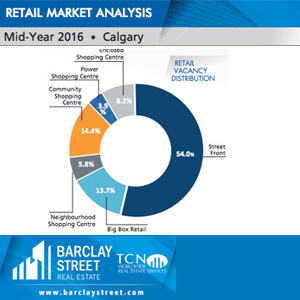In contrast to Calgary’s soaring office vacancy rate, its retail vacancy rate remains one of the lowest in North America despite being at an all-time high.
 An 11.1 per cent retail vacancy rate in Calgary’s central business district (CBD) contributed to the city’s overall retail vacancy rate rising to an all-time high of 3.4 per cent.
An 11.1 per cent retail vacancy rate in Calgary’s central business district (CBD) contributed to the city’s overall retail vacancy rate rising to an all-time high of 3.4 per cent.
“The retail vacancy in the core business districts of Calgary can largely be attributed to increased office vacancy rates as well as a general slowdown in our oil-based economy here,” said Nathaniel Sterzik, leasing and sales associate for Barclay Street Real Estate, which just released its mid-year retail market analysis for the city.
“Due to large-scale layoffs of professionals across the city, pedestrian traffic in usually busy areas has all but died.”
It’s not just stores that are being hard hit by this trend. Sterzik said restaurants have also suffered.
“Several closures of large-format restaurants are proof that the money and ability to spend it in such entertainment venues is dwindling. There has also been a general shift in large oil companies to ban the consumption of alcohol during the workday, further affecting the revenues for restaurants that make up an overwhelming majority of the services that the core boasts.”
Calgary retail composition
Calgary retail is composed of: 23.8 per cent power shopping centre; 22.3 per cent enclosed shopping centre; 19.9 per cent community shopping centre; 13.9 per cent street front; 11.2 per cent neighbourhood shopping centre; and 8.8 per cent big box retail.
“The composition of retail formats across Calgary has long been argued as contributing to excessive urban sprawl with the development of so many suburban/destination power centres and shopping areas,” said Sterzik. “This however is really more a way of life for Albertans in general, as we overwhelmingly tend to commute by vehicle to these areas on the way to or from our suburban homes.
“As much as we are improving the nature of developments across the city with higher density mixed-use projects and the revitalization of pedestrian corridors in the CBD, the composition of retail format is still concentrated on suburban centres that are supporting the outlying commuter neighbourhoods.”
Retail vacancies in Calgary have this distribution: 54 per cent street front; 14.4 per cent community shopping centre; 13.7 per cent big box retail; 8.2 per cent enclosed shopping centre; 5.8 per cent neighbourhood shopping centre; and 3.9 per cent power shopping centre.
“Retail rental rates have dropped marginally in the street front asset classes across the core business districts,” said Sterzik, who added that considerable demand for retail space in new suburban developments and pedestrian-friendly areas of the city — including Inglewood, Kensington and 17th Avenue — have kept rents relatively stable.
Increasing retail inventory
While about 15 million square feet of retail inventory has been added in Calgary since 2008, including 165,200 square feet this year, another 332,000 square feet are scheduled to be delivered later this year alone.
There’s a lot under construction as well, including: 244,500 square feet in the CBD; 2.86 million square feet in the suburban south; and 3.33 million square feet in the suburban north.
While development continues, many retailers have also started adopting more online marketing and purchasing strategies in order to augment sales at brick and mortar outlets.
“Some large-format retailers have adjusted their push-marketing and service-based strategies to facilitate those customers looking to save time through ‘click and collect’ outlets,” said Sterzik.
“These have indeed become far more common, and a great example of a recent entry to this segment is Loblaws, with their click and collect service for groceries. This continues to draw traffic into the stores themselves, where customers can pick up their online orders as well as fill in any potential gaps in their list while there.”
Calgary retail vacancies still comparatively low
Calgary’s previous high retail vacancy rate was 3.1 per cent in the third quarter of 2008. Inventory at that time was approximately 25 million square feet, 63 per cent of the current volume.
While Calgary’s retail vacancy rate is high by historical standards, Barclay Street director of research Anthony Scott said it’s still one of the lowest — if not the lowest — in North America. He cited a May survey by Ten-X which recommended American markets to invest in and which showed the lowest retail vacancies were in northern Virginia (5.2 per cent), Miami (six per cent) and Los Angeles (6.4 per cent).
Barclay Street’s research forecasts that there will be sustained demand for quality retail space in Calgary well into next year.







